Simvastatin ameliorates established pulmonary hypertension through a heme oxygenase-1 dependent pathway in rats
- PMID: 19409105
- PMCID: PMC2681458
- DOI: 10.1186/1465-9921-10-32
Simvastatin ameliorates established pulmonary hypertension through a heme oxygenase-1 dependent pathway in rats
Abstract
Background: Simvastatin has been shown to ameliorate pulmonary hypertension by several mechanisms in experimental animal models. In this study, we hypothesized that the major benefits of simvastatin in pulmonary hypertension occur via the heme oxygenase-1 pathway.
Methods: Simvastatin (10 mg/kgw/day) was tested in two rat models of pulmonary hypertension (PH): monocrotaline administration and chronic hypoxia. The hemodynamic changes, right heart hypertrophy, HO-1 protein expression, and heme oxygenase (HO) activity in lungs were measured in both models with and without simvastatin treatment. Tin-protoporphyrin (SnPP, 20 micromol/kg w/day), a potent inhibitor of HO activity, was used to confirm the role of HO-1.
Results: Simvastatin significantly ameliorated pulmonary arterial hypertension from 38.0 +/- 2.2 mm Hg to 22.1 +/- 1.9 mm Hg in monocrotaline-induced PH (MCT-PH) and from 33.3 +/- 0.8 mm Hg to 17.5 +/- 2.9 mm Hg in chronic hypoxia-induced PH (CH-PH) rats. The severity of right ventricular hypertrophy was significantly reduced by simvastatin in MCT-PH and CH-PH rats. Co-administration with SnPP abolished the benefits of simvastatin. Simvastatin significantly increased HO-1 protein expression and HO activity in the lungs of rats with PH; however co-administration of SnPP reduced HO-1 activity only. These observations indicate that the simvastatin-induced amelioration of pulmonary hypertension was directly related to the activity of HO-1, rather than its expression.
Conclusion: This study demonstrated that simvastatin treatment ameliorates established pulmonary hypertension primarily through an HO-1-dependent pathway.
Figures

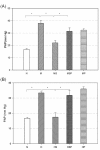
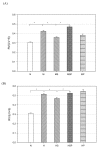
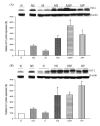
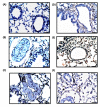
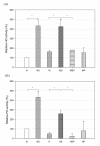
References
-
- Barnes PJ, Liu SF. Regulation of pulmonary vascular tone. Pharmacol Rev. 1995;47(1):87–131. - PubMed
MeSH terms
Substances
LinkOut - more resources
Full Text Sources
Other Literature Sources
Medical

